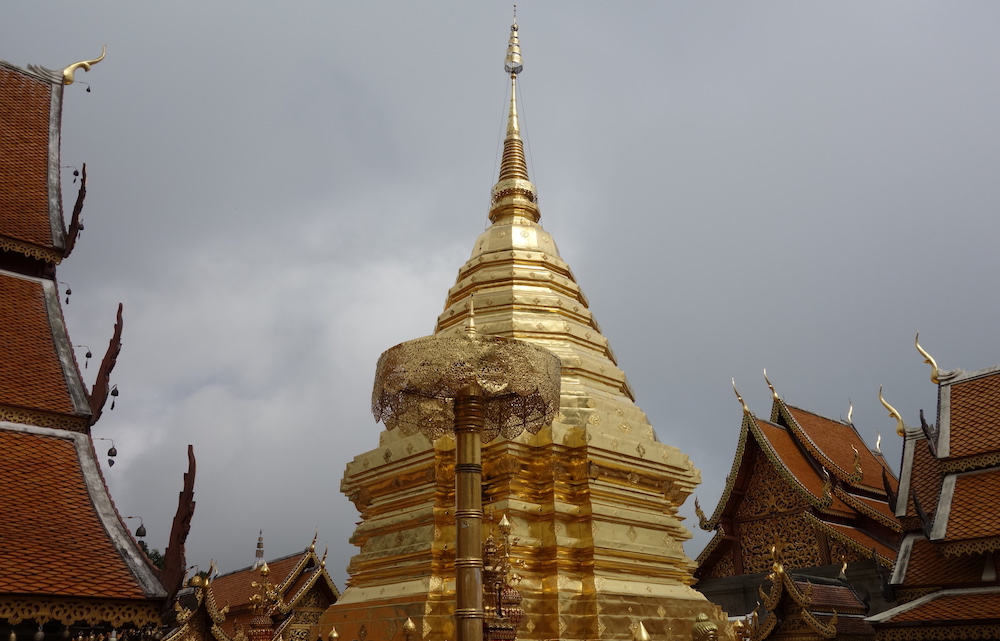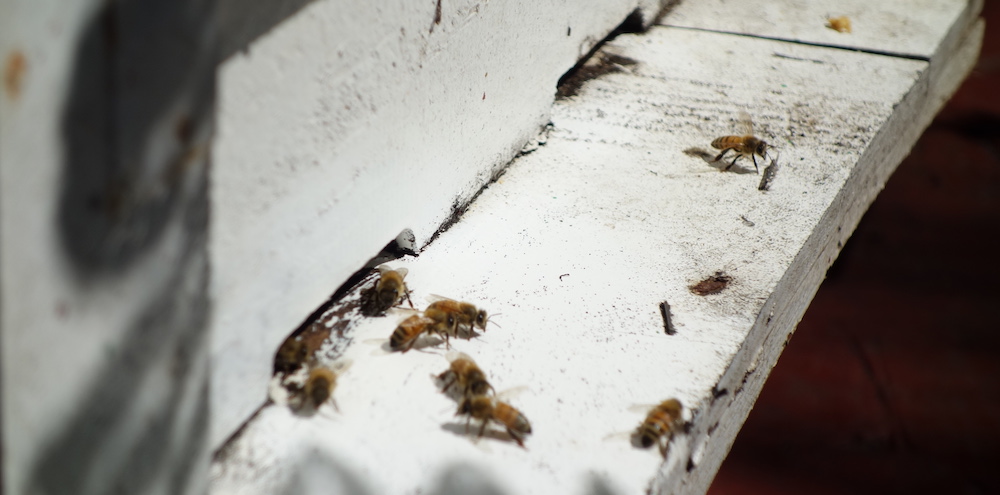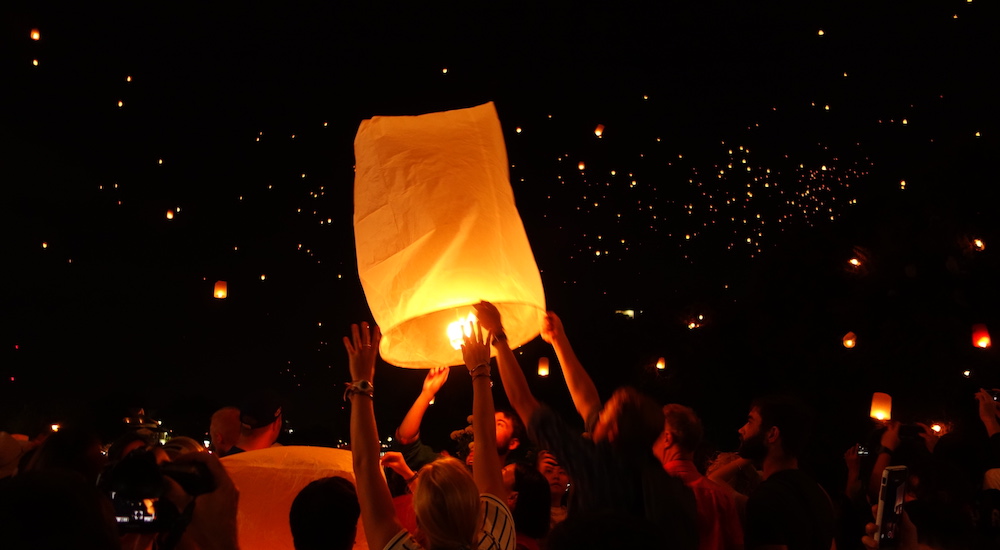Chiang Mai, Thailand
Chiang Mai — this was the place I was most excited about, because I had heard people talk about it so much. Though really I think I had glossed over the details, so in reality I knew very little about it. Mainly I had heard about it being the coworking capital of Southeast Asia (more on that later).
Chiang Mai means “new city” and is the largest city in northern Thailand. Seemingly like most cities in continental Southeast Asia, it was once the capital of some long-since-past kingdom. In the case of Chiang Mai it was the Lan Na kingdom in the 13th century, which before that was in Chiang Rai. Because of its dynastic history a defensive square moat was constructed each side 1.5 km, and the moat remains in good condition now with bridges all along. Inside the moat is known as the “old city”. The moat creates a confusing flow of traffic — the road on the outside perimeter of the moat runs clockwise and counterclockwise inside the moat. So going from point A to point B often involves a series of U-turns.
Centered around old city is a series of about three rings roads, highways really, intersected by radial highways leading in and out. It felt surprisingly well-designed. The west side of the city is flanked by Doi Suthep, a small mountain with a famous temple Wat Phra That Doi Suthep, that is lit up at night overlooks the city.
 Wat Phra That Doi Suthep
Wat Phra That Doi Suthep
Seraphi
But our introduction to the city was gradual because our first destination was Seraphi (or Serapee), well south of the city. The Uber driver had a hard time finding the place — it was far past the 3rd ring road. But we got there eventually, an old rustic Thai style house. Thai houses are traditionally raised on stilts away from the flooding that comes in the rainy season, and the house is set apart from the kitchen and the bathroom — as was the case in this guesthouse.
Also, every traditional Thai house has a house shrine (or “spirit house)”, which looks like a mini house on a dais, and can be found throughout Thailand, Laos, Cambodia and Burma. Please the spirits of the shrine (with daily offerings and prayer) and you will keep a happy house. The house shrine also should not lie in the shadow of the house. Actually these shrines are not limited to houses, but can be found outside apartment buildings, shopping mails and other businesses.
The staff at our guest house spoke little English and managed using the Google translate app. This was quite contrary to our experience in Phuket where everywhere was filled with tourists and felt tailored for tourists. In Seraphi there were few people who could speak English but there was good food, and interesting places to be found: a honey factory, a fruit-drying factory and a 20-min motorbike drive to the famous Baan Tawai craft village.
 Bees outside the honey factory in Seraphi
Bees outside the honey factory in Seraphi
House Hunting & Checkpoints
After spending a few days of down time Seraphi we began our search for a month-long rental closer to the center, one where I would be able to settle on a coworking spot. This was November, high season for tourism in northern Thailand. This house hunting turned into about three and a half days roaming around some areas northwest of the Old City — mainly near the huge Chiang Mai University; and Nimmanhemmin, the epicenter of expat life in Chiang Mai.
 Doi Suthep mountain from the large reservoir on CMU campus
Doi Suthep mountain from the large reservoir on CMU campus
On our first day house hunting driving through the Old City once inside the moat we came face-to-face with the reality of being outsiders in a place where authorities have unquestioned control, but used arbitrarily. That is to say… corruption. In this case, it was in the form of a “tourist checkpoints” — where the police round up any motorbike riders who don’t look Thai to find some way to get them to pay a fine (improper license, improper motorbike, improper helmet, unpaid road tax — all of this in some gray area of legal offense).
My fine: 500 baht for an international driver’s license without a stamp for driving a motorcycle. My payment would excuse me for up to 3 days, after which point, if caught again, I would pay the same fine. Luckily there was no next time, mainly because once we left Seraphi we gave up the motorbike. The whole experience was disturbing because I felt I had been violated — albeit in a very mild form. I saw many checkpoints over the many weeks we were in Chiang Mai — and we have not seen them anywhere else in Thailand.
After 3 days of hunting we still hadn’t quite decided and we’re able to move in right away so we stayed a few nights at a Japanese run hostel that we very accidentally came upon. This was a super convenient place and Asa discovered many interesting people to play with and chat in Japanese.
Later on we settled on an Airbnb apartment sandwiched between a Japanese nightclub and a late night BBQ buffet restaurant. The apartment itself was a sizable studio, with a semi-functional kitchen and a view of the mountains. The kitchen was a tricky part — since Thai houses don’t often have indoor kitchens, many apartments don’t have any kitchens and people instead prefer to just eat out or buy their meals for take out.
Loi Krathong
The main attraction for November is Loi Krathong — the lantern lighting full moon festival. Historically special time is the last full moon of the Thai year when people make a special floating lantern to make a wish for the coming year. The floating lanterns were usually highly decorated rafts (some small, some large) with a lit candle placed on the river. This seems to have evolved at some point to sky lanterns — cloth boxes with a little fuel cell inside, enough heat to make the lantern rise high into the sky if it doesn’t crash and burn to the ground first.
We went to Narawat Bridge — the epicenter of the sky lantern lighting. Really it was almost entirely filled with eager, half-drunk or full-drunk tourists lighting up lanterns and releasing them skyward with some success and some scary failure.
 Loi Krathong at Narawat Bridge
Loi Krathong at Narawat Bridge
Still, there was something quite magical about it. So it’s easy to look past the environmental impact and the impact to air traffic — which is why the sky lanterns are altogether banned in Bangkok.
Coworking Capital
My first pick for coworking spot turned out to be full — which I didn’t anticipate. So I trudged down the street to a neighboring spot and settled down for (what ended up being) 5 weeks of work. It was mostly filled with young male Europeans. On hot days it felt like I was in a sweaty gym, every programmer on their own hamster wheel. But I had no working schedule — so I worked most weekends when it was always quiet and took off the occasional weekday so the three of us could explore Chiang Mai.
I looked at about 8 different coworking places all over Chiang Mai, and really the one I found was pretty good (though not nearly as pleasant as the one I was at in Ubud). Before arriving in Chiang Mai I thought it would be either the kind of city that feels like a mini tech hub (with lots of tech startups) or a tech getaway center (catering to traveling tech workers). Neither was true really. There are startups and plenty of traveling techies. But I think the rise of coworking spots in Chiang Mai is because it’s a very expat friendly place outside of the expensive Bangkok rat race.
This really boils down to my own reeducation about what coworking is and is becoming. Coworking is for everyone — occasional travelers and perpetual expats — but really it’s also (forgive the cliche) a lifestyle. As remote work becomes more possible for all professions, not just programmers and developers, coworking companies broaden their appeal by offering subscriptions to a network of offices throughout Asia or the world. Travel and work, travel and work, travel and work — as separated or mixed together as you like. In this respect, Chiang Mai is only unique in that it seems to have started this early — so it’s established, but not quite matured yet. It will be interesting to see how this changes as the startups in the area really do start to take off and who will be the undisputed leader in coworking.